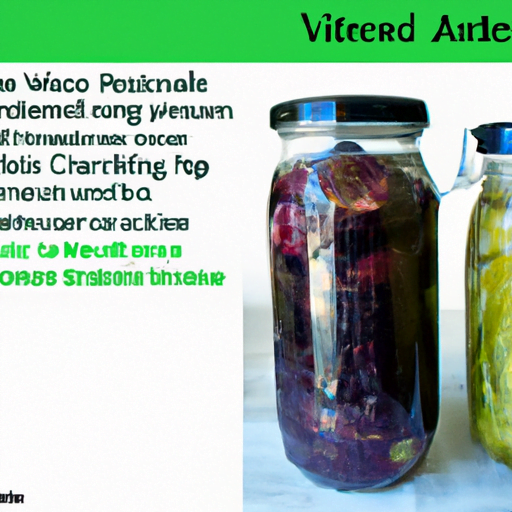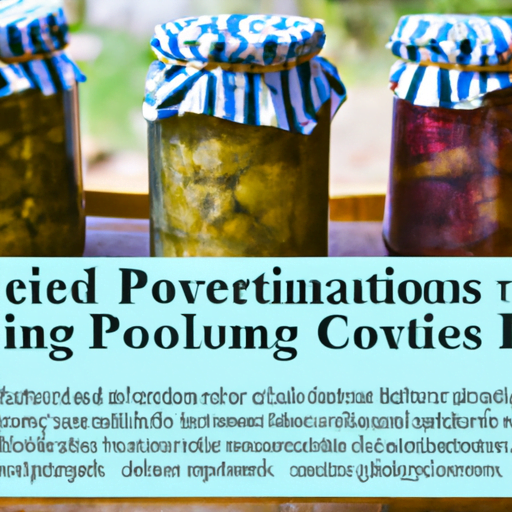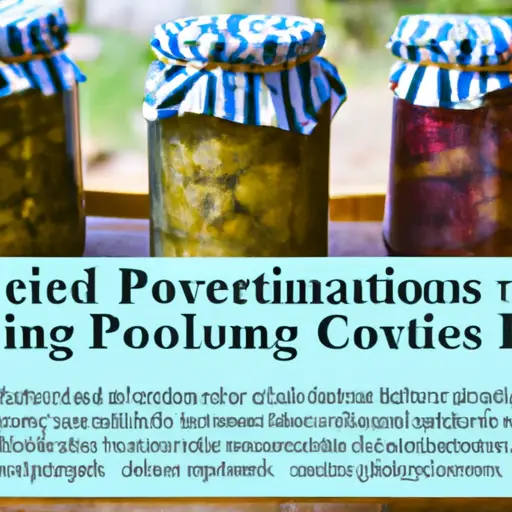Have you ever wondered how people used to preserve food before the invention of modern refrigeration? Or maybe you’re curious about the different methods of food preservation that are still widely used today. Well, you’re in luck because we’re about to dive into the fascinating world of food preservation. In this article, we’ll explore the most common methods of food preservation and how they can help you extend the shelf life of your favorite fruits, vegetables, and more.
When it comes to food preservation, there are several tried and true methods that have been used for centuries. One of the most common methods is canning, which involves sealing food in airtight containers and heating them to destroy any bacteria or microorganisms that could cause spoilage. Another popular method is drying, which involves removing the moisture from food to prevent the growth of bacteria and mold. Fermentation is yet another method that has been used for thousands of years, allowing bacteria or yeast to convert sugars in food into alcohol or acid, thereby preserving it.
In this article, we’ll delve deeper into each of these methods, discussing their pros and cons, and providing tips and tricks for successful food preservation. Whether you’re interested in learning how to can your own homemade jam, or you want to start fermenting your own sauerkraut, we’ve got you covered. So, if you’re ready to unlock the secrets of food preservation, keep reading and get ready to become a master preserver in no time.

Introduction
Food preservation is the process of extending the shelf life and maintaining the quality of food by preventing or slowing down spoilage caused by microorganisms, enzymes, or external factors such as heat, light, and moisture. It plays a vital role in ensuring that food is safe to eat and remains nutritious for longer periods. Being able to preserve food is a crucial skill that has been practiced for centuries, allowing people to store and consume food long after it’s been harvested or prepared.
Traditional Methods of Food Preservation
Throughout history, various traditional methods of food preservation have been developed to preserve food without the use of modern technology. These methods have proven to be effective and have been passed down from generation to generation. Let’s explore some of the most common traditional food preservation techniques.
Canning
Canning is a method of food preservation that involves sealing food in jars or cans to create an airtight environment, preventing the growth of microorganisms and spoilage. The principle behind canning is to heat the food to a high temperature and then rapidly cool it to kill bacteria and other organisms. This method is commonly used for preserving fruits, vegetables, meats, and even soups and sauces.
Salting
Salting is one of the oldest methods of food preservation. Salt acts as a natural preservative by drawing out moisture from food, creating an environment where bacteria cannot thrive. The salt also enhances the flavor of the food and inhibits the growth of certain spoilage-causing microorganisms. Foods that are commonly preserved using salting techniques include fish, meat, and vegetables.
Drying
Drying is a simple and effective method of food preservation that involves removing the moisture from the food, inhibiting the growth of bacteria and mold. This can be done by exposing the food to heat and air, either by sun drying, oven drying, or using a food dehydrator. Drying is commonly used for preserving fruits, vegetables, herbs, and even meats such as jerky.
Fermentation
Fermentation is a natural process that converts sugars in food into alcohol or organic acids using microorganisms such as bacteria or yeast. This process not only preserves the food but also enhances its flavor and texture. Examples of fermented foods include yogurt, sauerkraut, kimchi, and pickles.
Smoking
Smoking is a preservation method that involves exposing food to smoke produced by burning wood or other plant materials. The smoke acts as a natural preservative by inhibiting the growth of bacteria and mold. It also imparts a distinct smoky flavor to the food. Popular foods that are commonly smoked include fish, meat, cheese, and even vegetables.
Modern Methods of Food Preservation
With the advancement of technology, modern methods of food preservation have been developed to complement and improve upon traditional methods. These methods utilize more advanced techniques and equipment to extend the shelf life of food.
Refrigeration
Refrigeration is the most common method of food preservation used in households today. It involves storing food at low temperatures, typically between 35°F (1.7°C) and 40°F (4.4°C), to slow down the growth of spoilage-causing microorganisms. Refrigeration helps maintain the freshness and quality of perishable items such as fruits, vegetables, dairy products, and meats.
Freezing
Freezing is a method of food preservation that involves lowering the temperature of food to below its freezing point, typically 0°F (-18°C) or lower. Freezing inhibits the growth of microorganisms and preserves the nutrients and quality of the food for an extended period. Freezing is commonly used for preserving fruits, vegetables, meats, and prepared meals.
Vacuum Packing
Vacuum packing is a method of food preservation that involves removing air from the packaging before sealing, creating a vacuum environment. This method helps slow down the growth of spoilage-causing bacteria and fungi by reducing the oxygen level inside the package. Vacuum packing is commonly used for preserving meats, cheeses, and other perishable items.
High-pressure Processing
High-pressure processing (HPP) is a non-thermal food preservation method that involves subjecting food to high pressures, typically between 30,000 and 87,000 pounds per square inch (psi). HPP helps eliminate or reduce harmful bacteria while preserving the nutritional value and sensory qualities of the food. This method is commonly used for juices, sauces, and ready-to-eat meats.
Chemical Preservation
Chemical preservatives such as salt, sugar, vinegar, and various food additives are used in food preservation to inhibit the growth of bacteria, yeast, and mold. These preservatives often act by altering the pH or inhibiting enzymatic activity, effectively extending the shelf life of the food. They are commonly used in canned goods, baked goods, and processed foods.

Canning
Canning is a widely used method of food preservation, especially for fruits, vegetables, and other low-acid foods. The process involves thoroughly cooking the food and sealing it in sterile containers to create an airtight environment, effectively killing or preventing the growth of bacteria, yeast, and mold.
Principles of canning
The principles of canning revolve around heating the food to a specific temperature for a sufficient amount of time to destroy harmful microorganisms and enzymes. This process also creates a vacuum seal as the food cools, preventing any new contamination.
Hot water bath method
The hot water bath method is commonly used for preserving high-acid foods such as fruits and pickles. The food is heated to a temperature of 212°F (100°C) and then sealed in sterilized jars. The jars are then submerged in boiling water for a designated period, typically ranging from 5 to 20 minutes, depending on the type of food being preserved.
Pressure canning method
The pressure canning method is used for low-acid foods such as vegetables, meats, and soups, which require higher temperatures to ensure their safety. The food is sealed in sterilized jars and then heated under pressure to reach temperatures above the boiling point of water, typically around 240°F (116°C) or higher.
Benefits and drawbacks of canning
Canning offers many benefits, such as extending the shelf life of food for up to one year or more, preserving the nutrients and flavors of the food, and reducing food waste. However, it does require careful attention to detail and proper technique to ensure food safety. Over time, canned foods may also lose some of their nutritional value and quality.
Salting
Salting is a preservation method that has been used for centuries to preserve food, especially meats and fish. Salt acts as a natural preservative by drawing out moisture from the food, creating an inhospitable environment for bacteria and other microorganisms.
How salt preserves food
Salt works by dehydrating the food, which inhibits the growth of spoilage-causing bacteria. It also lowers the water activity level, making it difficult for microorganisms to survive and multiply. Additionally, salt can enhance the flavor of the food and act as a natural antioxidant.
Types of salt used in preservation
Different types of salt can be used for food preservation, including kosher salt, sea salt, and rock salt. These salts vary in texture, mineral content, and purity, but they all possess the ability to preserve food. It is important to note that iodized table salt should be avoided for preservation purposes due to the iodine content, which can affect the preservation process.
Salt-curing techniques
Salt-curing involves coating or packing the food with salt to draw out moisture and inhibit bacterial growth. This technique is commonly used for preserving meat, especially pork, and fish. The food is typically covered with a layer of salt or immersed in a salt brine for a certain period, allowing the salt to penetrate the tissue and preserve the food.
Examples of salt-preserved foods
Some examples of salt-preserved foods include salted pork (bacon), salt-cured fish (salted cod), and salted vegetables such as sauerkraut or salt-preserved lemons. These preserved foods can be stored for extended periods without refrigeration, making them valuable in regions or circumstances where refrigeration is not readily available.
Drying
Drying is one of the oldest methods of food preservation and involves removing moisture from the food to inhibit the growth of bacteria, mold, and yeast. This method has been used across different cultures and climates for centuries.
Methods of food dehydration
There are several methods of food dehydration, each with its own advantages and limitations.
Sun drying
Sun drying is one of the most traditional methods of drying and involves placing food out in the sun to dry naturally. The food is typically sliced or chopped into smaller pieces to allow quicker and more uniform drying. However, sun drying is highly dependent on weather conditions and can take several days or weeks to complete.
Oven drying
Oven drying is a common method that involves using low temperatures in an oven to remove moisture from the food. The temperature used depends on the type of food being dried and can range from 125°F (52°C) to 185°F (85°C). Oven drying provides a controlled environment and allows for quicker drying times compared to sun drying.
Dehydrator drying
Using a food dehydrator is a convenient and efficient method of drying food. The dehydrator circulates warm air around the food at a controlled temperature, typically between 130°F (54°C) and 160°F (71°C), effectively removing moisture. Dehydrators are designed specifically for drying food and offer precise temperature and time control.
Benefits and limitations of drying
Drying offers several benefits, including a long shelf life of dried foods, easy storage and portability, and retention of nutrients and flavors. However, the drying process can lead to loss of some nutrients, such as vitamin C, and can result in changes in texture and taste. It is also important to ensure proper drying to prevent the growth of bacteria and mold.
Fermentation
Fermentation is a natural process that involves the breakdown of sugars in food by microorganisms such as bacteria or yeast. This process not only preserves the food but also enhances its flavor and texture.
Principle of fermentation
During fermentation, microorganisms convert sugars into alcohol, organic acids, or gases. This process creates an acidic or alcoholic environment, making it difficult for spoilage-causing microorganisms to grow. The fermentation process typically involves the use of salt, which helps control the growth of undesirable bacteria.
Examples of fermented foods
Fermented foods are found in various cultures and cuisines around the world. Some common examples include yogurt, sauerkraut, kimchi, pickles, miso, and sourdough bread. These fermented foods offer unique flavors and textures, and they are known for their probiotic properties, which can benefit gut health.
Fermentation process
The fermentation process involves creating the right conditions for the desired microorganisms to thrive. This includes providing the appropriate temperature, moisture, and time for fermentation to occur. Different foods require specific conditions and starter cultures to initiate fermentation. Once the desired fermentation is achieved, the food can be stored for extended periods under proper conditions.
Health benefits of fermented foods
Fermented foods offer several health benefits. They can improve digestion, enhance nutrient absorption, boost the immune system, and support a healthy gut microbiome. The fermentation process breaks down complex carbohydrates and proteins, which can make the nutrients more bioavailable for the body.
Smoking
Smoking as a preservation method involves exposing food to smoke produced by burning wood or other plant materials. Smoked foods not only have an extended shelf life but also develop a distinct smoky flavor that is highly cherished.
Smoking as a preservation method
Smoking is a method of food preservation as the smoke contains natural antimicrobial properties that help prevent the growth of bacteria, yeast, and mold. Smoke also acts as a barrier, protecting the food from insects and other pests. Additionally, the heat generated during smoking can partially cook the food, further enhancing its preservation and making it more flavorful.
Types of wood used for smoking
Different types of wood lend different flavors to the smoked food. Common woods used for smoking include hickory, mesquite, applewood, cherry, and oak. Each wood imparts its own unique flavor, allowing for a diverse range of smoked food options.
Cold smoking vs hot smoking
Cold smoking and hot smoking are two distinct methods of smoking, each with its own purpose and technique.
Cold smoking involves smoking food at temperatures below 100°F (38°C) for an extended period, typically ranging from hours to days. This method is used primarily for flavoring and preserving food without actually cooking it. Common cold-smoked foods include salmon, cheese, and bacon.
Hot smoking, on the other hand, involves smoking food at higher temperatures, typically between 165°F (74°C) and 225°F (107°C). This method partially or fully cooks the food while imparting a smoky flavor. Popular examples of hot-smoked foods include smoked sausages, brisket, and ribs.
Popular smoked foods
Smoking is commonly associated with certain types of foods, such as smoked salmon, smoked bacon, and smoked ham. However, many other foods can be smoked, including poultry, seafood, cheese, nuts, and vegetables. The possibilities are endless, and smoking adds a unique and delicious flavor profile to these foods.
Refrigeration
Refrigeration is one of the most common modern methods of food preservation used in households around the world. It involves storing food at low temperatures to slow down the growth of spoilage-causing microorganisms.
How refrigeration preserves food
Refrigeration works by reducing the temperature of the food, inhibiting the growth of bacteria and other microorganisms. Cold temperatures slow down their metabolic activity, preventing them from multiplying and causing spoilage. Refrigeration also helps retain the nutritional value and quality of the food.
Ideal temperature for refrigeration
The ideal temperature for refrigeration ranges between 35°F (1.7°C) and 40°F (4.4°C). This temperature range ensures that perishable foods stay fresh and safe to eat for a longer period. It is important to maintain a consistent temperature in the refrigerator to prevent fluctuations that could compromise food safety.
Proper storage techniques
Effective storage techniques are crucial for maintaining food quality and safety in the refrigerator. Here are some guidelines to follow:
- Store raw meats, poultry, and seafood on the bottom shelf to prevent cross-contamination.
- Keep dairy products, such as milk and cheese, in sealed containers to prevent the absorption of odors.
- Separate fruits and vegetables to prevent the release of ethylene gas, which can accelerate spoilage.
- Store leftovers in airtight containers to maintain freshness and prevent the spread of bacteria.
- Regularly clean and organize the refrigerator to remove any spilled or spoiled food.
Common refrigerated foods
Common foods that are typically stored in the refrigerator include fresh fruits and vegetables, dairy products (milk, cheese, yogurt), eggs, raw meat and poultry, leftovers, and various condiments and beverages. Refrigeration helps extend the shelf life of these foods, ensuring they remain safe to consume.
Conclusion
Food preservation is a fundamental practice that has allowed humans to store and consume food for extended periods. From traditional methods such as canning, salting, drying, fermentation, and smoking to modern techniques like refrigeration, freezing, vacuum packing, high-pressure processing, and chemical preservation, there are numerous ways to preserve food and extend its shelf life.
Choosing the right preservation method depends on various factors such as the type of food, desired flavor and texture, available resources, and personal preference. It is important to understand the principles and techniques behind each preservation method to ensure food safety and quality.
The impact of food preservation on society cannot be underestimated. It has revolutionized the way we obtain and consume food, allowing us to have access to a wide variety of foods throughout the year. Food preservation has also played a crucial role in reducing food waste, improving food security, and enabling off-grid living.
In conclusion, exploring the most common methods of food preservation provides us with valuable knowledge and skills to preserve and enjoy food in a sustainable and efficient manner. Whether it’s canning, salting, drying, fermenting, smoking, or utilizing modern refrigeration techniques, food preservation is an essential practice that continues to benefit individuals, communities, and global food systems.




